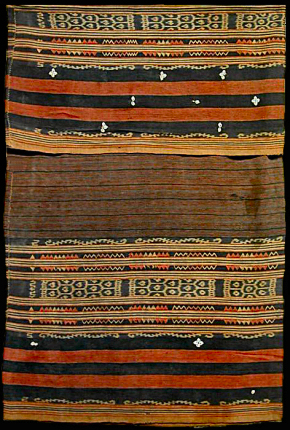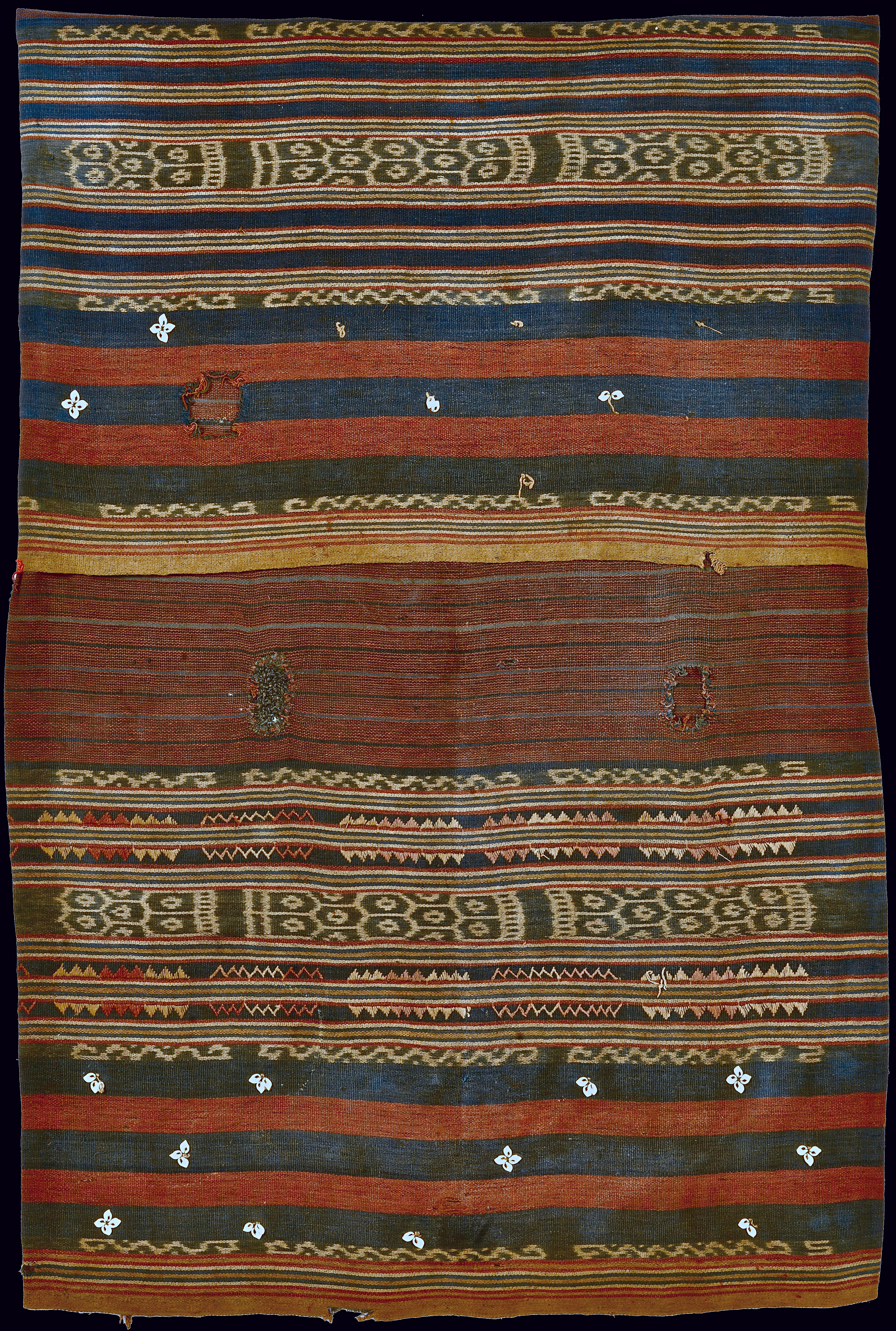| |
 mouse over to magnify mouse over to magnify
| | | | 267 Moluccas, Sermata
Tais (sarong)
| | Locale: | Note that the Sermata provenance is speculative, see below. | | Period: | 19th c. | | Panels: | 2 | | Design: | Overall design is that of Tanimbarese tais matin or bakan mnanat, the highest ranking sarong type. The honeycomb motif belongs to the Tanimbar vernacular, though this boxed variant is more common on Babar. Unusual is that the two panels have been joined, not so as to mirror each other, but in the same direction. Narrow ikated stripes with snake motifs. Bottom section of each panel has alternating dark blue and dark red plain bands, decorated with nassa shells. Narrow bands decorated with triangles in discontinuous supplementary weft, both filled and rendered in outline, similar to those on PC 268, and likewise done, not in silk, but in cotton. On Tanimbar such triangles are a mark of high rank. | | Size: | 64 x 130 cm (25.1 x 51.1 in) | | Weight: | 465 g (279 g/m2) | | Yarn: | Cotton, hand-spun, medium | | Comment: | Rare old ceremonial sarong of archaic appearance. Both top and bottom panel have been decorared with nassa shells. The majority of those on the top panel were attached on the inside of the cloth (hence invisible in this photograph), making clear that it was intended to be worn with the top rolled over. A few holes, some of them with old repairs in darning with hand spun yarn. Note that the Hunt Kahlenberg cognate (see below) was given the provenance 'Seremata, Tanimbar'. However, we have seen no map of Tanimbar that shows a Seremata or Sermata, and Van Vuuren never heard of a village of that name. Given the stylistic resemblances to Babar ikat we believe it to be most likely that both these cloths came from Sermata, which lies closer to Babar than to Tanimbar. According to Marianne van Vuuren women in Sermata often ordered ikat made on other islands. In such cases we consider the receiving culture as the provenance. Ex- collection J.B. Lüth. | | Background: | Additional information in chapters on Moluccas and Sermata. | | Published: | Ikat Textiles of the Indonesian Archipelago, 2018.
Ikat from Timor and its Outer Islands, 2022.
Ikat Textiles of Timor: Indonesian and Timor-Leste, 2025. | | Compare: | 195 288 195 | | Sources: | Near-identical to 19th sarong identified as 'Seremata, Tanimbar' in the Hunt Kahlenberg collection, #19091 in Tai Gallery (see below), apparently less affected by wear and tear. Similar to 19th c. Both have sewn-on nassa shells. Motifs related to those of Timor and especially Babar. Honeycomb motif similar to that in Van Vuuren, Ikat from Tanimbar, Fig. 79, p. 174, and Fig. 70, 173. Also similar to motif on half of a 1913 Babar sarong from Marsela depicted in Khan Majlis, Indonesische Textilien, Wege zu Goettern und Ahnen, Fig. 561. And similar to motif on Leti sarong PC 195. Also similar to motif on Leti shawl PC 238 when one closes the loops and compacts the shapes. The way the band with the main motif is bordered by snaking bands is similar to that of Babar sarong PC 288. In Lautem, East Timor a variant of this motif is also seen.
 | | |
 ©Peter ten Hoopen, 2025
All rights reserved.
|
|


